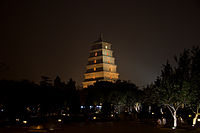- Giant Wild Goose Pagoda
-
Giant Wild Goose Pagoda or Big Wild Goose Pagoda (Chinese: 大雁塔; pinyin: Dàyàn Tǎ), is a Buddhist pagoda located in southern Xi'an, Shaanxi province, China. It was built in 652 during the Tang Dynasty and originally had five stories, although the structure was rebuilt in 704 during the reign of Empress Wu Zetian and its exterior brick facade was renovated during the Ming Dynasty. One of the pagoda's many functions was to hold sutras and figurines of the Buddha that were brought to China from India by the Buddhist translator and traveler Xuanzang.
Contents
Surroundings and history
 Statue of Xuanzang. Great Wild Goose Pagoda, Xi'an.
Statue of Xuanzang. Great Wild Goose Pagoda, Xi'an.
The original pagoda was built during the reign of Emperor Gaozong of Tang (r. 649-683), then standing at a height of 54 m (177 ft).[1] However, this construction of rammed earth with a stone exterior facade eventually collapsed five decades later. The ruling Empress Wu Zetian had the pagoda rebuilt and added five new stories by the year 704 AD. However, a massive earthquake in 1556 heavily damaged the pagoda and reduced it by three stories, to its current height of seven stories.[2] The entire structure leans very perceptibly (several degrees) to the west. Its related structure, the 8th century Small Wild Goose Pagoda in Xi'an, only suffered minor damage in the 1556 earthquake (still unrepaired to this day).[2] The Giant Wild Goose Pagoda was extensively repaired during the Ming Dynasty (1368–1644) and renovated again in 1964. The pagoda currently stands at a height of 64 m (210 ft) tall and from the top it offers views over the current city of Xi'an.
During the Tang Dynasty the pagoda was located within the grounds of a monastery, within a walled ward of the larger southeastern sector of the city, then known as Chang'an.[3][4] The monastic grounds around the pagoda during the Tang Dynasty had ten courtyards and a total of 1,897 bays.[3][5] In those days graduate students of the Advanced Scholars examination in Chang'an inscribed their names at this monastery.[3]
Close by the pagoda is the Temple of Great Maternal Grace; Da Ci'en. This temple was originally built in AD 589 and then rebuilt AD 647 in memory of his mother Empress Wende by Li Zhi who later became the Tang Emperor Gaozong.
The monk Xuanzang's statue stands in front of the temple area.
See also
Notes
References
- Benn, Charles (2002). China's Golden Age: Everyday Life in the Tang Dynasty. Oxford: Oxford University Press.
- Ingles, O.G. "Impressions of a Civil Engineer in China," The Australian Journal of Chinese Affairs (Number 7, 1982): 141–150.
- Heng Chye Kiang. (1999). Cities of Aristocrats and Bureaucrats: The Development of Medieval Chinese Cityscapes. Singapore: Singapore University Press. ISBN 9971692236.
- Watson, William. (2000). The Arts of China to A.D. 900. New Haven: Yale University Press. ISBN 0300082843.
External links
Categories:- Buildings and structures in Xi'an
- Chinese pagodas
- 650s architecture
- 700s architecture
- Tang Dynasty art
- Chinese architectural history
Wikimedia Foundation. 2010.



